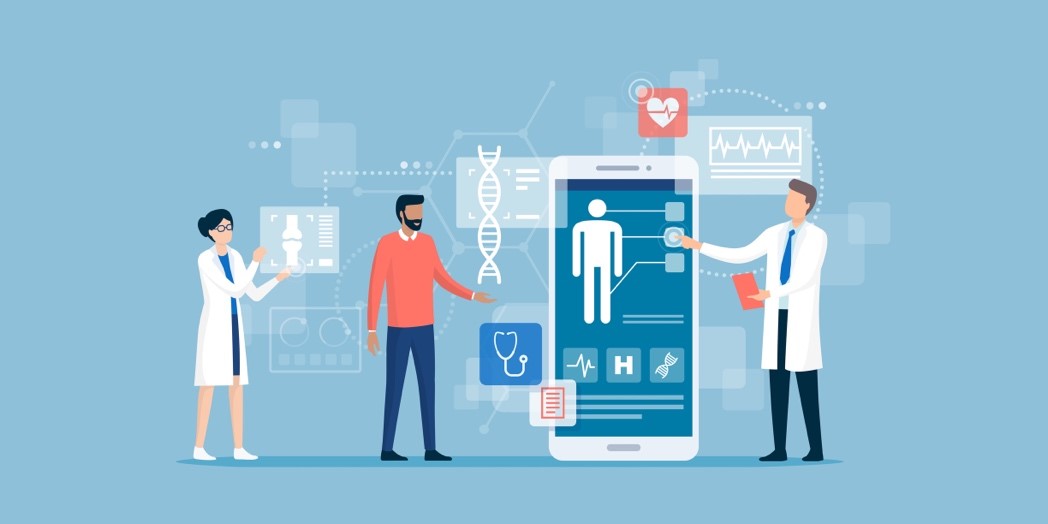
Insight by: Jon Warner
Although the Pharmaceutical industry has lagged behind other sectors of healthcare, such as many Payers and Providers (and a number of larger hospitals), it is now pretty widely appreciated that Digital health technologies can be used across the pharmaceutical value chain but especially when it comes to consumers or customers. For example, digital health and virtual care apps and wearables can be an integral part of decentralized clinical trials and therefore can be used for information-dissemination and education, vital sign monitoring, collecting electronic clinical outcome assessments, facilitating virtual visits with investigators, and monitoring investigational drug adherence and more. They can also be used to generate and collect digital biomarkers from sensors embedded in connected devices.
Because we are increasingly seeing a huge number of people use digital health apps to schedule an appointment, review prescriptions, and connect to doctors and other clinicians through a video call for online interactions, it has become increasingly urgent for the pharma sector to think about this trend and to evolve strategies to develop and /or adopt digital health tools to increase efficiency and effectiveness, both for them and their customers.
So, What Do Customers/Patients Want in a Digital Health App?
Customers of all kinds (clinical trial participants and patients-the term we will stick with here from now on) generally look for the four most basic functionalities – the ability to find information they want or need quickly, the ability to schedule/ cancel appointments and events, the ability to request drugs/prescriptions, and finally, easy access to their records or data in general. Although each pharma company will have its own unique path to follow, in the rest of this brief article, we will lay out a simple process that could be followed in designing or adopting digital health apps.
- Easy Access Functionality
It’s good to have unique functionalities in a new digital health app (whether they are built or bought), but the basic features need to be easily accessible to the target end-users. Patients (and for that matter physicians or other clinicians) will not use an app that adds extra time to what they currently spend on caring for others and/or for themselves. This means that users of digital health apps look for solutions that help them save time on unnecessary administration, booking, changing, or cancelled appointments and other tasks. A successful digital health app is therefore one that provides easy access to all the necessary functionalities. It should save a significant amount of time and effort, instead of adding more (however small this may be).
- Detailed, Actionable Information
Providing information just for the sake of it will not make a digital health app successful.
Patients want to learn about their condition, the causes, and then take action, based on the available opportunities. Clinicians want easy to find data and summary information and even to have simple dashboards they can review quickly. Apps should therefore always be designed or utilized in such a way that it seamlessly walks users through the digital health solution to the part or parts that gives them the most useful and actionable information and/or insights.
- Easy Communication
A well-designed digital health app should allow patients to easily interact with pharma company staff or provider partner healthcare professionals. For example, providing a platform where users can connect and talk with doctors or clinical trial supervisors helps patients and their clinicians and others alike, and can save time and effort on visits to hospitals or clinics and allows doctors, nurses and other clinical supervision staff to serve their patients on a more personal level, at speed and often at scale.
- Patient Community
Patients often want to connect and interact with one another (especially when they are in a clinical trial together, for example). That’s why it’s often important to ensure a community feature is added to a digital health app. There are many benefits that arise from including social features in an app. When an individual is diagnosed with a particular illness or disease, he or she would most likely want to connect with people diagnosed with a similar condition. This helps patients feel comfortable and part of a supportive community. It can also be a great tool to keep patients engaged with the app, and therefore feel more connected to the pharma company.
- Simple Yet Amazing Digital Experience
Consumers today expect a smooth user experience. Poor user experience can be a reason why the vast majority of mobile health apps fail to make a great first impression. Hence, it’s important that a digital health app has a user-friendly User Interface (UI and UX). Apps that provide attractive data visualization are much more likely to retain and engage patients. App users typically prefer pages and designs that have soothing colors and a clean interface with minimal clutter. It’s obviously also important to make sure to keep the target audience in mind while designing the overall appearance.
- Integration with Wearable Devices
Wearable devices such as health trackers and smartwatches are commonplace now. The faster adoption rate offers an excellent opportunity to develop digital health apps that can be easily integrated with wearable devices such as these. The wearable device can gather critical data such as heart rate, blood sugar, tremors, posture control, sleep patterns, physical activities and much more. This data can help patients learn more about their routines and provide more control over their health and provides critical data (individually and in aggregate) for the pharma company).
- Always Develop a Minimum Viable Product (MVP) First
Developing a Minimum Viable Product or MVP is a simple way to know what customers really want to see in a digital health app. MVP, as the name suggests, is the most basic version of an app that has all the primary features. It can also help you generate a lot of actionable insights from early adopters which can then inform future adaptation and new features.
In summary, digital health tools and solutions in general and ‘apps’, in particular, are now ubiquitous in many healthcare organizations. As a result, many pharmaceutical companies can benefit greatly by both potentially developing their own solutions, often using ‘low-code’ or ‘no-code’ solutions that require little effort and much lower costs. Examples here are companies such as Performance Health Partners and Cogniss. They can also use third party solutions that can be tailored and branded for individual pharma company use and dissemination in many areas. An example here are companies such as Twilio that is the communication technology behind a ‘digital front door’ solution for instance. Although some pharmaceutical companies have some talent to do this internally, it is often useful to recruit this talent from elsewhere in the healthcare sector and beyond, and then supervise this app development and expansion effort. The payoffs for doing this are likely to be significant in many ways!




